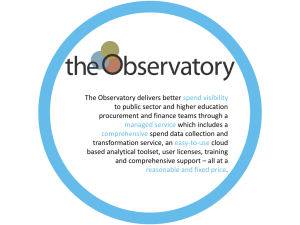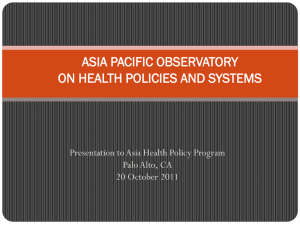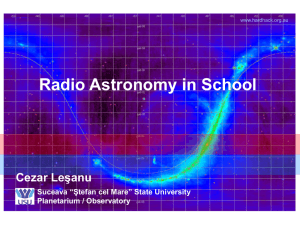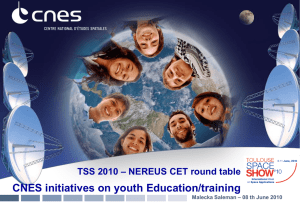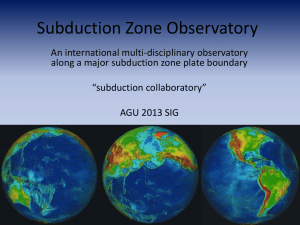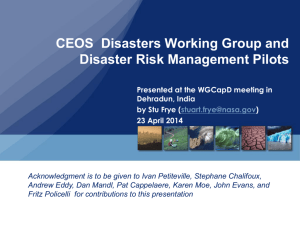PPT - CEOS
advertisement
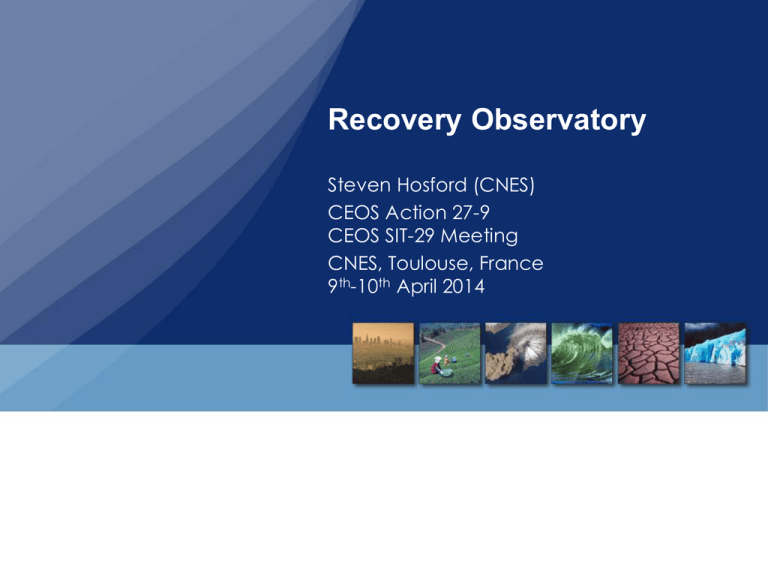
Recovery Observatory Steven Hosford (CNES) CEOS Action 27-9 CEOS SIT-29 Meeting CNES, Toulouse, France 9th-10th April 2014 Recovery Observatory – the need SIT-29 Meeting CNES, Toulouse, France 9th-10th April 2014 Indonesian Tsunami 2004 Hurricane Katrina 2005 Haiti Earthquake 2010 Deepwater Horizon 2009 Tohoku Tsunami 2011 Photo credits: www.nationalgeographic.com; www.mediamythalert.com; www.tampabay.com; www.manongeo.wordpress.com; www.japansociety.org.uk. 2 Recovery Observatory – the idea SIT-29 Meeting CNES, Toulouse, France 9th-10th April 2014 Response (weeks) Recovery (years) Recovery Observatory (3-5 yrs) Organise EO data from response phase and pre-disaster in repository International Charter Sentinel-Asia EO data from National Agencies Commercial providers Copernicus/GMES Coordination Effective Resource Allocation Clear Institutional Links Plan coordinated acquisitions to support: • Built area damage assessment (initial and later detailed); • Natural resource and environment assessment; • Reconstruction planning; • Reconstruction monitoring; and • Change monitoring. Ad Hoc Approach Lack of Coordination and Cooperation Lack of Institutional Links Lack of Awareness of Role of EO 3 SIT-29 Meeting CNES, Toulouse, France 9th-10th April 2014 Recovery Observatory – the proposal Recovery Observatory Implementation: • Oversight Team (CNES, ESA, JAXA, NASA, ASI) created summer 2013 • Proposes ONE Observatory as part of Observation Strategy 2014-2016 • Builds on success of Charter, Sentinel-Asia and KalHaiti project • Detailed analysis completed • Next steps: • Preparation (conditions for triggering, infrastructure establishment, liaison with DRR stakeholders, generic planning) – begins now! • Cold storage • Triggering • Operations (3-5 years) • Closing • Recovery Observatory ready for triggering by 28th Plenary (November 2014) • Preparation Phase completed April 2015 4 SIT-29 Meeting CNES, Toulouse, France 9th-10th April 2014 Recovery Observatory – EO data requirement (I) Recovery Observatory Data Requirement Overview: • EO data requirement limited because area of interest is small – only concerns affected area • EO data during response would be covered by International Charter – agreement with providers required to place data and Charter products in Observatory • Data for recovery limited to monitoring at regular intervals – weeks or months initially, then quarterly • Effort from Agencies can be on best effort basis after initial “critical mass” is secured • Critical mass refers to key data sets over affected area to establish situational awareness (during response) and track change over time: • High resolution optical and radar data before and after event, and at regular intervals (weekly or monthly, then quarterly) • IT infrastructure required to organise data (linkages to distributed storage, meta data, related products archive, forum for users) 5 SIT-29 Meeting CNES, Toulouse, France 9th-10th April 2014 Recovery Observatory – EO Data Early Estimate (after response) Type Frequency Total images (4 yrs) Products HR/VHR SAR Quarterly over large areas; asc and desc passes over highly affected area for detailed InSAR assessment 400 images Products developed quarterly; initial damage assessment, dedicated change detection products (InSAR) HR/VHR Optical Mosaic coverage before and after event; updates quarterly only over critical areas Depends on area affected – 400 images? Situational awareness, change detection, damage mapping, recovery monitoring, rehabilitation monitoring (environment) General comment: difficult to predict exact volume but area will be limited; frequency less than for response; Likely total volume during recovery (monthly/quarterly for 3 – 5 years) not to exceed total volume during initial response (daily for weeks); best effort commitment. Total volume expected is much lower (x100) than the total volume of data delivered by space agencies in support to FCT/GFOI or Supersites 6 SIT-29 Meeting CNES, Toulouse, France 9th-10th April 2014 Recovery Observatory – focus of current effort Recovery Observatory Oversight Team – Issues Being Addressed: • IT Infrastructure and related planning • Working through WGISS, CEOS to propose solid IT approach to organise access to data and support usage • Outreach to stakeholders (Red Cross, UNISDR) and involvement in partnership (triggering) • Key DRR partners to support triggering process by recommending appropriate event and coordinating relationship with national end user • EO data licensing – moving from ad hoc, diverse licensing to standard approach. Eventual use by RO contributors: • Propose new “open” licence tailored to image data which would be adopted by data providers • Considerably simplify the requirements on the IT infrastructure (management of one licence/set of access constraints) • Contributions under different licenses still welcome 7 SIT-29 Meeting CNES, Toulouse, France 9th-10th April 2014 Recovery Observatory – Preparation Phase Preparation Phase 1 (now til November 2014): • WGISS begins consultations on IT infrastructure, canvasses potential contributions; architecture defined. Basic IT architecture put in place. • Recovery Observatory Oversight Team to initiate dialogue with international DRM stakeholders. Synergy with 2015 WCDRR activities for the selection of the stakeholders. • Initial RO activation plan to be in place by November 2014 Preparation Phase 2 (November 2014 – Mid 2015): • Long-term IT architecture established; transfer to new architecture of RO already triggered. Otherwise, beginning of cold storage. • Data licensing discussions 8 SIT-29 Meeting CNES, Toulouse, France 9th-10th April 2014 Decision CEOS SIT is asked to endorse the set up of ONE CEOS Recovery Observatory. The following steps will be undertaken: • Initiate the Preparation Phase which will work out key implementation issues (triggering, infrastructure, partnerships, …) • Enable a triggering of the Observatory from November 2014 Plenary, if a major disaster occurs and CEOS decides to trigger Recovery Observatory. Note that: • After presentation at last 2013 Plenary, a SIT endorsement constitutes approval in principle for ONE CEOS RO in the 20142016 period (running for 3 to 5 years). • “In principle” contributions of data sets from agencies for the Recovery Observatory will be sought during the preparation phase and will only be confirmed at triggering (a quick decision will be required) 9
